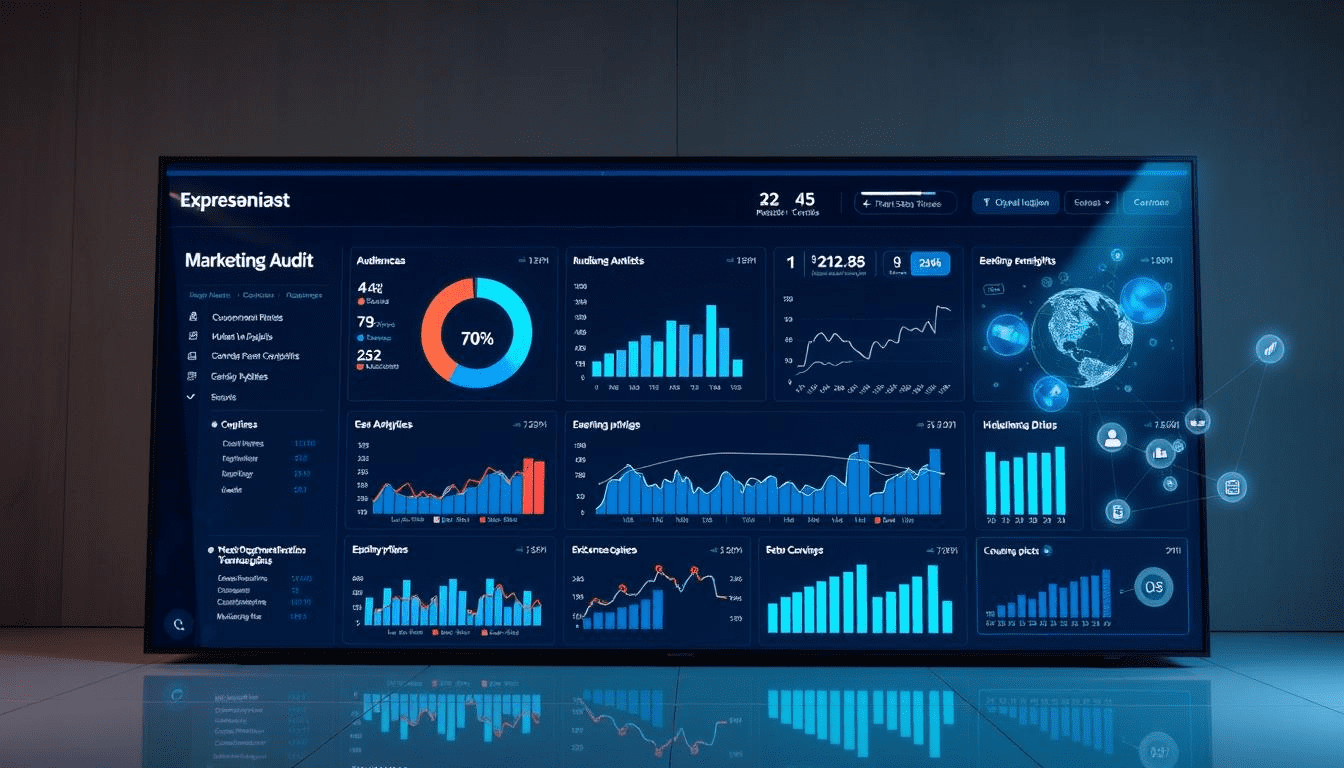Last quarter, a marketing director faced the board with disappointing campaign results. Despite spending thousands on ads, the company couldn’t prove which efforts actually drove revenue. The CEO asked one simple question: “What’s our return on investment?”
This moment of silence highlights a widespread challenge. Businesses invest heavily in online channels but struggle to track actual returns. The good news? Companies that measure their return on investment are 1.6 times more likely to see positive results.
We’ve crafted this guide to help you excel in digital marketing ROI by 2026. The average company now sees returns between 300% and 500%, with email campaigns reaching an impressive 4,200%.
Today’s challenges extend beyond basic calculation. Rising customer acquisition costs, complex attribution across touchpoints, and AI-powered tools have transformed the game. We’ll share practical strategies for measuring marketing performance metrics that truly matter.
Our approach spans from fundamental tracking methods to advanced ROI optimization techniques. You’ll learn to craft a digital marketing strategy that balances automation with authentic content. It will also respect privacy-first data collection.
Key Takeaways
- Businesses tracking their returns achieve 1.6x better performance than those that don’t measure results
- Average campaign returns range from 300% to 500%, with email channels leading at 4,200%
- AI-powered tools and first-party data collection dominate 2026’s marketing landscape
- Successful measurement requires tracking multiple customer touchpoints across the buying journey
- Strategic frameworks focus on future growth, not just past performance analysis
- Attribution complexity demands sophisticated tracking systems and clear methodology
- Privacy-conscious data practices now directly impact campaign effectiveness and measurement accuracy
1. Measuring Your Current Digital Marketing ROI
Every dollar invested in digital marketing tells a story, but only if we know how to read the numbers. Before optimizing campaigns or reallocating budgets, we must establish a clear baseline. Accurate measurement transforms random marketing activities into strategic investments that drive predictable growth.
Understanding current performance creates the foundation for meaningful improvement. Without reliable data, we’re flying blind, making decisions based on intuition. The good news is that with the right marketing metrics and calculation methods, we can gain complete visibility into what’s working and what’s draining resources.
This measurement process isn’t just about filling spreadsheets with numbers. It’s about creating feedback loops that inform every future decision. When we know our true return on investment, we gain the confidence to scale successful campaigns and the clarity to cut underperforming ones.
The Core Formula and Key Performance Indicators
The ROI calculation formula provides the mathematical backbone of all performance measurement. At its simplest, we calculate ROI as: ROI (%) = (Net Profit / Cost) × 100, where Net Profit equals Return minus Cost. This straightforward formula reveals how many dollars we generate for every dollar spent.
Yet, this basic formula only tells part of the story. We need to track several interconnected metrics to understand the complete picture of our marketing performance.

The conversion rate measures the percentage of leads who take our desired action. This metric reveals how effectively we’re moving prospects through the funnel. A low conversion rate often signals messaging problems or targeting issues, regardless of how much traffic we generate.
Cost per acquisition represents the total expense required to gain one new customer. We calculate this by dividing all campaign expenses by the number of customers acquired. This metric helps us understand the efficiency of our acquisition strategies across different channels.
Revenue per customer shows us the average amount each customer contributes to our bottom line. When we multiply this by the number of customers acquired, we get the total revenue attributed to our marketing campaigns. Tracking all campaign expenses is critical here, including ad spend, software subscriptions, labor costs, and overhead allocation.
“What gets measured gets managed. Without clear metrics, marketing becomes an expense, not an investment.”
Net profit represents the real value we create after subtracting all costs from revenue. Many marketers make the mistake of tracking gross revenue without accounting for product costs, fulfillment expenses, and operational overhead. This oversight can make unprofitable campaigns appear successful on the surface.
Understanding Acquisition Costs and Long-Term Customer Value
Customer lifetime value and customer acquisition cost form the most important ratio in sustainable marketing. These two metrics work together to reveal whether our marketing investments create long-term profitability or short-term losses.
Customer Acquisition Cost (CAC) includes every expense involved in converting a prospect into a paying customer. We calculate it by adding up all marketing and sales costs for a specific period, then dividing by the number of new customers acquired. For example, if we spend $10,000 on marketing in a month and acquire 50 customers, our CAC is $200.
Customer lifetime value represents the total revenue we expect from a customer throughout their entire relationship with our business. The basic calculation multiplies average purchase value by purchase frequency and customer lifespan. A customer who spends $100 per month and stays with us for 24 months has a customer lifetime value of $2,400.
The relationship between these metrics determines our marketing sustainability. The ideal CLV:CAC ratio is 3:1 or higher, meaning each customer should generate at least three times what we spent to acquire them. A ratio below 3:1 suggests we’re spending too much on acquisition or not generating enough long-term value.
This ratio directly informs our budget allocation decisions. When we identify channels delivering a high CLV:CAC ratio, we know we can confidently invest more resources there. Channels with ratios below 3:1 require immediate optimization or budget reallocation.
Understanding these metrics also helps us make smarter strategic choices. For instance, if our customer lifetime value is $2,400 and our current CAC is $800 (a 3:1 ratio), we know we can afford to increase acquisition spending up to approximately $800 per customer while maintaining profitability. This knowledge removes the guesswork from scaling decisions.
Industry Standards and Performance Targets for 2026
Setting realistic ROI benchmarks requires understanding both general industry standards and the specific factors affecting our business. These benchmarks provide context for evaluating our performance and identifying opportunities for improvement.
According to current industry data, small and medium-sized businesses typically achieve a 500% return on investment, or a 5:1 ratio. This means for every dollar invested, they generate five dollars in return. Performance varies significantly across different marketing channels.
Email marketing consistently delivers exceptional results, achieving an average of 4,200% ROI or 42:1 ratio. This outstanding performance makes email one of the most cost-effective channels available. SEO strategies deliver strong returns as well, generating approximately 2,200% ROI or 22:1 over time.
Pay-per-click campaigns typically deliver 200-400% ROI, while social media marketing generates 175-200% returns. These lower numbers don’t necessarily mean these channels are less valuable, they often serve different purposes in the customer journey, such as awareness and consideration.
For B2B companies, the average ROI sits at 500% with a 5:1 ratio. B2B SEO strategies achieve the highest returns at 748% over three years, making them valuable for long-term growth. The cost per lead averages $942 for organic B2B marketing, compared to $1,907 for paid channels, a significant difference that affects overall campaign profitability.
The visitor-to-lead conversion rate in B2B averages 2.2%, providing a useful benchmark for evaluating landing page and funnel performance. If our conversion rate falls significantly below this threshold, we know optimization should be a priority.
Several factors influence these ROI benchmarks and explain why performance varies across businesses:
- Product pricing:Higher-priced products typically support higher acquisition costs while maintaining profitable ROI ratios
- Sales cycle length:Longer sales cycles delay revenue recognition and can make ROI appear lower in short-term measurements
- Market maturity:Established markets with intense competition often require higher marketing investments to achieve the same results
- Business model:Subscription businesses with recurring revenue can justify higher CAC than one-time purchase models
- Channel mix:Companies using diverse channel strategies often see blended ROI that differs from single-channel benchmarks
These benchmarks serve as guideposts, not absolute targets. Exceptional performance in one channel may compensate for average performance in another, creating an overall strategy that exceeds industry standards. The key is understanding where we excel and where we need improvement, then making data-driven decisions to optimize our entire marketing ecosystem.
By establishing these measurement foundations now, we create the visibility necessary to implement strategic optimizations. Accurate measurement isn’t the end goal, it’s the beginning of a continuous improvement process that drives sustainable ROI growth.
2. How to Increase ROI in Digital Marketing Through Strategic Optimization
A structured optimization process can transform underperforming campaigns into revenue-generating assets. Instead of constantly seeking new tactics, focusing on systematic optimization of existing efforts yields faster and more predictable ROI improvements. This method demands discipline, data analysis, and the courage to make tough decisions about resource allocation.
The following four-step framework offers a clear path to enhance your digital marketing performance. Each step builds upon the previous one, creating a holistic strategy that addresses common ROI challenges across various industries.
Conducting a Thorough Marketing Audit
Every successful optimization journey starts with understanding your current state. A detailed marketing audit uncovers hidden inefficiencies, untapped opportunities, and structural issues that silently drain your budget. It’s essential to dedicate sufficient time to this foundational step, avoiding the rush to tactical changes.
Your marketing audit should examine these critical components:
- Account structure analysis:Review how campaigns, ad groups, and keywords are organized across platforms
- Performance metrics assessment:Analyze conversion rates, cost per acquisition, and ROI across all active channels
- Audience targeting evaluation:Verify that your targeting parameters align with your ideal customer profiles
- Creative asset review:Assess the relevance and effectiveness of ad copy, images, and video content
- Conversion funnel mapping:Identify drop-off points and friction areas throughout the customer journey
Unstructured accounts are a common problem we find during audits. These accounts often feature campaigns competing for the same keywords, ad groups mixing unrelated products or services, and inconsistent naming conventions that complicate reporting. They also have overlapping audience targeting, which inflates costs unnecessarily.
“The biggest wins in digital marketing don’t come from finding new channels, they come from fixing what’s already broken in your existing campaigns.”
Document all findings in an organized format that categorizes issues by severity and impact. This documentation becomes your optimization roadmap, helping prioritize which improvements will deliver the greatest ROI lift.
Identifying and Scaling Your Top-Performing Channels
Once your marketing audit reveals the complete picture, we focus on identifying and amplifying what already works. Channel performance analysis requires looking beyond surface-level metrics to understand the underlying factors driving success.
Start by calculating true ROI for each marketing channel, accounting for all associated costs including platform fees, creative development, and management time. Many marketers make budget allocation decisions based on incomplete data, leading to underfunding high-performers while overspending on channels with hidden costs.

Look for patterns that explain why certain channels outperform others. Does your audience respond better to visual content on social platforms? Do search campaigns convert better for specific product categories? Understanding these dynamics helps you make smarter scaling decisions.
When reallocating resources to top performers, we recommend a measured approach:
- Increase budgets by 20-30% initially while monitoring performance stability
- Test scaling during different time periods to identify optimal windows
- Expand targeting gradually to avoid audience dilution
- Maintain experimental budgets for testing new approaches within proven channels
Resist the temptation to abandon experimental channels too quickly. Some marketing initiatives require longer timeframes to demonstrate true value. Yet, proven winners deserve adequate investment to reach their full scale.
Eliminating Low-ROI Activities and Strategic Resource Reallocation
This step often proves the most challenging because it requires making difficult decisions about stopping initiatives that consume time and money without delivering proportional returns. Yet strategic resource management separates high-performing marketing teams from those perpetually struggling with budget constraints.
Establish clear criteria for determining which campaigns or tactics to pause. We typically recommend stopping activities that fail to meet these benchmarks:
- Campaigns generating negative ROI after sufficient optimization attempts (minimum 90 days)
- Channels with customer acquisition costs exceeding customer lifetime value
- Tactics requiring disproportionate management time relative to revenue contribution
- Initiatives with declining performance trends despite optimization efforts
Calculate the opportunity cost of continuing underperforming activities. Every dollar and hour invested in low-ROI initiatives represents resources unavailable for high-potential opportunities. This perspective shift makes elimination decisions more objective and less emotional.
When reallocating freed resources, prioritize based on documented performance data, not preferences or assumptions. Budget allocation should flow to channels and campaigns with proven track records of efficient customer acquisition and strong conversion rates.
Implementing Conversion Rate Optimization Tactics
Conversion optimization is the most cost-effective method for improving ROI because it increases returns without requiring additional traffic investment. Small improvements in conversion rates compound dramatically across large traffic volumes, making this optimization area highly valuable.
Landing page optimization is the cornerstone of effective conversion rate improvement. Your landing pages should implement these proven principles:
- Message matching:Ensure landing page headlines and content directly reflect the promises made in your ads
- Friction reduction:Minimize form fields, remove unnecessary navigation options, and streamline the conversion path
- Trust signal integration:Add customer testimonials, security badges, industry accreditations, and money-back guarantees
- Mobile optimization:Design responsive experiences that load quickly and function flawlessly on smartphones
A/B testing provides the methodology for systematic improvement. Instead of making changes based on intuition, we test variations against control versions to measure actual impact on conversion rates and revenue.
Prioritize A/B testing ideas based on their impact and implementation difficulty. High-impact, low-effort tests should receive immediate attention, while complex tests with uncertain outcomes can wait until you’ve captured easier wins.
Quality Score improvements in paid search campaigns can significantly reduce cost-per-click while improving ad positions. Focus on these three Quality Score components:
- Expected click-through rate:Write compelling ad copy that earns clicks from qualified prospects
- Ad relevance:Ensure tight alignment between keywords, ad copy, and user intent
- Landing page experience:Deliver fast-loading pages with content directly relevant to the search query
Even modest conversion rate improvements deliver substantial ROI gains. A campaign converting at 2% that improves to 2.5% represents a 25% increase in conversions with zero additional traffic cost. When applied across multiple campaigns and channels, these improvements transform overall marketing profitability.
Monitor your optimization efforts continuously, tracking not just conversion rates but also average order value, customer quality metrics, and long-term retention patterns. True conversion optimization considers the complete customer value equation, not just initial conversion actions.
3. Enhancing Campaign Performance With Data Verification
Data quality is not just a technical issue; it’s a key driver of marketing success and profitability. Every invalid email address, disconnected phone number, or outdated contact record wastes marketing dollars and missed revenue opportunities. By implementing systematic contact data verification , organizations can ensure their campaigns reach real, engaged prospects, transforming their marketing ROI.
The shift towards privacy-first marketing in 2026 makes data accuracy more critical than ever. With third-party cookies disappearing and privacy regulations tightening, first-party data becomes your most valuable marketing asset. Clean, verified contact information allows you to build direct relationships with customers, maximizing the return on every marketing investment.
Why Data Quality Directly Impacts Marketing ROI
Poor data quality creates a cascade of problems that directly erode your marketing returns. When your database contains invalid contacts, every campaign you launch wastes resources on recipients who will never engage. This inefficiency compounds across channels, affecting everything from email deliverability to advertising performance.
Consider the financial impact of bad data on email marketing. Industry research shows that email databases decay at approximately 22.5% annually as people change jobs, abandon addresses, or switch providers. If you’re sending campaigns to a list of 10,000 contacts without email verification, roughly 2,250 of those addresses become invalid each year.
The costs extend beyond wasted sends. Bounced emails damage your sender reputation, causing inbox providers to filter future messages into spam folders or block them entirely. A single campaign with high bounce rates can reduce deliverability for months afterward, affecting even your valid subscribers.
Inaccurate data also distorts your performance metrics and leads to flawed strategic decisions. When your analytics include interactions from invalid contacts, bot submissions, and duplicate records, you can’t accurately calculate true conversion rates or customer acquisition costs. This corrupted data feeds into your advertising platforms, preventing them from optimizing toward genuine high-quality leads.
We’ve observed that tracking accuracy is absolutely critical for proving conversions and feeding signals back to advertising platforms. Without proper email validation and clean contact data, optimization becomes impossible and ROI cannot be proven. Modern advertising platforms rely on conversion data to refine their targeting algorithms, feed them poor data, and they’ll optimize toward the wrong audience profiles.

Implementing Email Verification and Online Email Validation
Email remains the cornerstone of digital marketing communication, making email verification essential for campaign success. Implementing systematic online email verification protects your sender reputation while ensuring your messages reach real prospects who can actually convert into customers.
Email validation operates at multiple levels to assess address quality. Syntax validation checks that addresses follow proper formatting rules, while domain verification confirms that the email domain exists and can receive messages. The most thorough level, mailbox validation, verifies that the specific mailbox is active and capable of receiving emails without performing an actual send that could trigger spam filters.
The ROI benefits of implementing online email validation are immediate and measurable. Organizations typically see bounce rates drop from 5-15% down to under 2% after implementing verification processes. This improvement directly translates to better deliverability rates, higher engagement metrics, and reduced infrastructure costs from processing fewer bounces.
Choosing an Email Validation Tool for Your Campaigns
Selecting the right data verification tool for email validation requires evaluating several critical capabilities. The most important factor is accuracy, your chosen solution should achieve at least 95% accuracy in identifying invalid addresses while minimizing false positives that would incorrectly flag valid contacts.
We recommend prioritizing tools that offer both real-time and bulk verification capabilities. Real-time verification integrates with your forms and landing pages to validate addresses at the point of capture, preventing bad data from entering your database. Bulk verification allows you to clean existing lists before launching campaigns.
Look for these essential features when evaluating email validation options:
- API integration capabilitiesthat connect with your CRM, marketing automation platform, and other systems
- Multiple verification checksincluding syntax, domain, and mailbox-level validation
- Catch-all detectionto identify servers that accept all addresses regardless of validity
- Disposable email detectionto flag temporary addresses often used for fraudulent signups
- Processing speedappropriate for your volume requirements, specially for real-time validation
Compliance features matter significantly in 2026’s regulatory environment. Your data verification software should maintain GDPR, CCPA, and other relevant privacy regulation compliance. Verify that the provider doesn’t store validated email addresses longer than necessary and offers data processing agreements that protect your liability.
Best Practices for Online Email Verification
Timing is everything when implementing email verification processes. We’ve found that validation at multiple touchpoints provides the most complete data quality protection while minimizing list decay between campaigns.
Implement online email verification at these critical moments:
- Point of capture:Validate addresses in real-time as users submit forms, subscribe to lists, or create accounts
- Pre-campaign verification:Run bulk validation on your entire list before each major campaign send
- Regular hygiene cycles:Schedule quarterly verification of your complete database to catch addresses that became invalid after last validation
- After bounce events:Immediately remove or flag addresses that hard bounce despite prior validation
How you handle invalid addresses affects both data quality and customer relationships. For addresses that fail validation, implement a confirmation workflow that gives users the opportunity to correct typos instead of immediately removing them. Many invalid addresses result from simple data entry errors, “gamil.com” instead of “gmail.com”, that users can quickly fix when prompted.
Create a systematic process for re-engagement before removal. Contacts who haven’t engaged in 6-12 months should receive targeted win-back campaigns before being suppressed. This approach balances list hygiene with revenue opportunity, as re-engagement campaigns often reactivate valuable customers who simply missed recent communications.
Leveraging Phone Number Verification for Multi-Channel Campaigns
Modern marketing extends far beyond email, making phone number verification essential for complete contact data verification strategies. As SMS marketing, WhatsApp business messaging, and voice campaigns grow in popularity, validated phone data becomes critical for multi-channel success.
Phone number verification confirms that numbers are correctly formatted, active, and capable of receiving your intended message type. The process identifies disconnected numbers, landlines in your mobile SMS list, and invalid formats that would result in failed deliveries and wasted messaging costs.
The stakes for phone validation are exceptionally high because SMS and voice campaigns typically cost significantly more per contact than email. A single SMS campaign sent to an unverified list can waste thousands of dollars on disconnected numbers while damaging your sender reputation with telecommunications providers.
Benefits of Online Phone Number Verification
Implementing online phone number verification delivers immediate improvements across your multi-channel marketing operations. We consistently see organizations reduce SMS campaign waste by 15-30% after implementing phone validation, directly improving ROI by eliminating spend on unreachable contacts.
Contact rate improvements represent another significant advantage. When your call center teams work from verified phone lists, connection rates typically increase by 20-40% compared to unverified data. This efficiency gain reduces per-lead contact costs while accelerating your sales cycle.
Phone number verification also enhances personalization capabilities by providing carrier information and line type data. Knowing whether a number is mobile or landline allows you to route communications appropriately, SMS to mobile numbers, voice calls to landlines, improving engagement by delivering messages through the right channel.
Fraud prevention represents an often-overlooked benefit of phone verification. By identifying virtual phone numbers, VoIP lines, and other high-risk number types, verification helps you flag potentially fraudulent account creations and protect your marketing database from contamination.
Building a Complete Contact Data Verification Strategy
Effective data quality management extends beyond individual verification tools to encompass a complete strategy that maintains accuracy across all contact data types. The most successful organizations treat data verification as an ongoing process, not a one-time cleanup project.
Your contact data verification approach should address multiple data types simultaneously. Email addresses, phone numbers, postal addresses, and demographic information all require validation to ensure campaign accuracy. Integrated verification processes that handle multiple data types within a single workflow are more efficient than managing separate tools for each data category.
Building verification into your data collection processes prevents contamination at the source. Prevention is always more cost-effective than remediation, validating data as it enters your systems costs a fraction of the expense required to clean databases after they’ve accumulated years of invalid records.
Selecting Data Verification Software That Scales
As your marketing operations grow, your data verification software must scale without compromising accuracy or creating processing bottlenecks. The verification solution appropriate for a startup with 5,000 contacts looks very different from what an enterprise with 5 million contacts requires.
Evaluate processing capacity carefully when selecting data verification software. Calculate your peak verification volumes, including bulk list cleaning, real-time form validations, and API calls from integrated systems, then choose a solution with capacity well above your current needs to accommodate growth.
Pricing structures significantly impact long-term costs as your database expands. Some providers charge per verification, while others offer monthly credits or unlimited verification within subscription tiers. We’ve found that organizations with high verification volumes typically achieve better economics with subscription models, while those with occasional verification needs may prefer pay-per-use pricing.
Consider these factors when evaluating scalability:
- Processing speed:Can the system handle your peak volumes without delays that affect user experience?
- Accuracy guarantees:Does quality remain consistent as verification volumes increase?
- API rate limits:Will throttling restrictions affect your real-time verification implementations?
- Support for international data:Can the system verify contacts across all your operating regions?
Integrating Data Verification Tools Into Your Marketing Stack
The technical integration of your data verification tool determines how effectively it protects data quality across your marketing operations. Seamless connections between verification systems and your existing platforms create automated workflows that maintain data hygiene without manual intervention.
CRM integration represents the highest priority for most organizations. Connecting your email verification and phone validation capabilities directly to your CRM ensures that every contact record undergoes validation before being used in campaigns. This integration should operate bidirectionally, with verification results updating CRM records automatically.
Marketing automation platform connections enable pre-campaign verification that protects deliverability and performance. Configure your automation workflows to trigger bulk verification before each campaign deployment, automatically suppressing invalid contacts and flagging records that require review.
Form validation at the point of entry prevents bad data from entering your systems. Implement real-time verification on all lead capture forms, registration pages, and checkout processes. This approach improves data quality while providing better user experience through immediate feedback when visitors enter invalid contact information.
For organizations with large existing databases, establish batch processing schedules that regularly verify contact data even when it’s not actively being used. Quarterly verification cycles catch contacts that became invalid between campaigns, ensuring your database remains clean and ready for deployment.
The investment in complete data verification pays dividends across every aspect of your marketing operations. Clean, validated contact data improves deliverability, reduces waste, enhances targeting accuracy, and provides the reliable metrics needed for continuous optimization. In 2026’s privacy-first marketing landscape, verified first-party data represents a sustainable competitive advantage that directly drives higher ROI across all your campaigns.
4. Advanced ROI Maximization Techniques for 2026
Forward-thinking businesses are now using next-generation techniques that combine machine learning, marketing automation, and behavioral intelligence. These strategies leverage technology and data science while maintaining human judgment. The goal is to find the right balance, using AI optimization and predictive analytics for complex analysis and execution, while experienced marketers control brand strategy and creative direction.
We’re entering an era where marketing technology can process millions of data points in seconds. It identifies patterns invisible to human analysis and adjusts campaigns in real-time. This doesn’t replace marketing expertise; it amplifies it. The most successful companies in 2026 will be those that embrace these advanced tools while maintaining strategic oversight.
Hyper-Personalization Through Audience Segmentation
Generic messaging no longer cuts through the noise of modern digital channels. Today’s consumers expect experiences tailored to their needs, preferences, and behaviors. Personalization has evolved beyond inserting a first name into an email subject line, it now encompasses dynamic content that adapts in real-time based on user characteristics and actions.
Advanced audience segmentation goes beyond basic demographic targeting. We can now create micro-segments based on behavioral patterns, psychographic profiles, and predictive indicators. For example, instead of targeting “women aged 25-34,” we can identify “frequent mobile shoppers who browse outdoor gear on weekends, abandon carts at checkout, and respond positively to free shipping offers.”
AI-powered segmentation tools analyze thousands of customer attributes simultaneously to identify patterns that human analysts might miss. These systems can detect that customers who view product videos are 40% more likely to convert, or that users who engage with educational content have higher lifetime values than those who only view promotional materials.
The ROI impact of sophisticated audience segmentation is substantial. Research shows that personalized experiences can increase conversion rates by 20% to 30% compared to generic campaigns. Customer acquisition costs decrease because messaging resonates more strongly with target audiences, requiring fewer impressions to drive action.
Dynamic content delivery takes personalization to the next level. Your website homepage can display different hero images, product recommendations, and calls-to-action based on whether a visitor is a first-time guest, a returning browser, or an existing customer. Email campaigns can automatically adjust product recommendations based on browsing history and past purchases.

Implementing hyper-personalization across channels requires integration between your marketing platforms. Your email system needs to communicate with your website analytics, CRM, and advertising platforms. This unified approach ensures that a customer who browses winter coats on your website sees relevant coat ads on social media and receives an email featuring similar products, all without manual intervention.
We recommend starting with one or two high-impact personalization initiatives. Focus on your highest-value customer touchpoints, perhaps your homepage for returning visitors or your abandoned cart email sequence. Measure the performance improvement, then expand your personalization efforts based on proven results.
Marketing Automation for Cost Efficiency
Scaling marketing efforts without proportionally scaling costs is essential for ROI growth. Marketing automation enables this by handling repetitive, rules-based tasks that would consume significant human resources. The goal isn’t to replace marketers but to free them from tedious execution work so they can focus on strategy, creativity, and relationship building.
Modern automation platforms can manage complex workflows that respond to customer behaviors in real-time. When a prospect downloads a whitepaper, automation can trigger a nurture sequence, assign a lead score, notify a sales representative, and schedule follow-up tasks, all without manual intervention. This immediate response improves conversion rates while reducing the labor costs associated with lead management.
Workflow automation extends across the entire customer lifecycle. We can automate welcome sequences for new subscribers, engagement campaigns for active users, re-engagement efforts for dormant contacts, and win-back campaigns for churned customers. Each workflow operates based on defined triggers and conditions, ensuring that the right message reaches the right person at the right time.
Lead scoring systems represent one of the most valuable applications of marketing automation. These systems automatically assign points to prospects based on their behaviors and characteristics. A visitor who views pricing pages might receive more points than someone who only reads blog posts. Someone with a corporate email address might score higher than a personal Gmail account. When scores reach defined thresholds, automation can route high-value leads to sales teams for immediate follow-up.
Automated reporting saves countless hours while providing more accurate insights than manual analysis. Modern platforms can generate daily performance dashboards, weekly campaign summaries, and monthly ROI reports without human intervention. This consistent reporting helps us identify trends faster and adjust strategies before small problems become expensive mistakes.
The “human-in-the-loop” approach ensures that automation enhances strategic thinking. We use automation to handle execution, sending emails, posting social content, adjusting bids, while maintaining human control over messaging, brand positioning, and strategic priorities. Marketers review automated campaign performance, provide feedback to improve algorithms, and make judgment calls that require creativity and brand understanding.
Identifying which tasks to automate requires careful consideration. Repetitive activities with clear rules and defined outcomes are ideal automation candidates. Email sequences triggered by specific behaviors, social media posting schedules, and routine performance reporting all meet these criteria. Creative work like developing campaign concepts, writing compelling copy, and building customer relationships requires human insight and empathy that automation cannot replicate.
Multi-Touch Attribution Modeling
One of digital marketing’s most complex challenges involves fairly crediting the various touchpoints that contribute to conversions. A customer might first discover your brand through a social media ad, research products through organic search, compare options by clicking a retargeting ad, and convert after receiving an email promotion. Which channel deserves credit for the sale?
Simple attribution modeling approaches like last-click attribution give all credit to the final touchpoint before conversion. This undervalues awareness and consideration channels that introduce customers to your brand. First-click attribution makes the opposite mistake, ignoring all the nurturing that happens between initial contact and final purchase.
More sophisticated models distribute credit across multiple touchpoints. Linear attribution divides credit equally among all interactions. Time-decay models give more weight to touchpoints closer to conversion. Position-based attribution credits both the first and last touchpoints heavily while distributing remaining credit to middle interactions.
Data-driven attribution modeling represents the most advanced approach. These systems use machine learning to analyze thousands of customer journeys and determine how much each touchpoint actually contributes to conversions. The algorithms identify patterns like “customers who click display ads and then engage with email are 3x more likely to convert than those who only see emails.”
Proper attribution leads to better budget allocation decisions. If your analysis reveals that social media ads rarely convert directly but significantly increase conversion rates for email campaigns, you can justify social media spending as an essential awareness channel. This prevents the common mistake of cutting effective channels that don’t generate last-click conversions.
Cross-device and cross-channel tracking presents significant technical challenges for attribution modeling. A customer might browse products on a mobile phone during their commute, research options on a work computer during lunch, and complete the purchase on a home tablet in the evening. Connecting these sessions to a single customer journey requires sophisticated identity resolution technology.
Modern attribution platforms address these challenges through probabilistic and deterministic matching. Deterministic matching uses logged-in user data to definitively connect sessions across devices. Probabilistic matching uses behavioral signals, device characteristics, and statistical modeling to infer connections with high confidence even when users aren’t logged in.
Predictive Analytics and AI-Driven Optimization
The frontier of ROI maximization lies in using predictive analytics to forecast outcomes and AI-driven systems to optimize campaigns faster than human marketers can. These technologies analyze historical data to identify patterns, then apply those patterns to predict future behaviors and outcomes with remarkable accuracy.
Predictive models can forecast which leads are most likely to convert, allowing sales teams to prioritize their efforts on high-probability opportunities. They identify customers at risk of churning before they actually leave, enabling proactive retention efforts. They predict which products customers are likely to purchase next, powering recommendation engines that increase average order values.
Market condition forecasting helps us anticipate how seasonal factors, competitive activities, and economic trends will affect campaign performance. This forward-looking insight enables proactive budget adjustments, increasing spending ahead of high-opportunity periods and scaling back before market conditions deteriorate.
AI-driven campaign optimization continuously tests variables and automatically implements winning approaches. Automated bid management systems adjust bids thousands of times per day based on real-time conversion probability, maximizing results while maintaining target cost-per-acquisition thresholds. These systems respond to performance changes far faster than manual bid adjustments could.
Dynamic budget allocation represents another powerful application of AI optimization. Instead of setting fixed budgets for each channel at the beginning of the month, AI systems can shift spending daily based on performance trends. If paid search is delivering exceptionally strong ROI on Tuesdays, the system automatically increases Tuesday budgets and reduces spending on lower-performing days.
Creative optimization through AI testing accelerates the learning process. Traditional A/B testing might compare two ad variations over several weeks. AI-powered multivariate testing can simultaneously evaluate dozens of combinations, different images, headlines, calls-to-action, and landing pages, identifying winning combinations in days. This rapid iteration improves performance while reducing the opportunity cost of running underperforming creative.
The most effective marketing automation strategies maintain human oversight while leveraging AI for execution speed and analytical depth.
Despite their power, AI systems have important limitations that require human oversight. Algorithms optimize for the objectives we define, but they can’t determine whether those objectives align with broader business goals. They identify patterns in historical data but can’t anticipate unprecedented market shifts or competitive moves. They test variations efficiently but can’t generate breakthrough creative concepts that redefine category standards.
The most successful 2026 marketing organizations will adopt a balanced approach. They’ll use predictive analytics to inform strategic decisions while maintaining human judgment about brand positioning and customer relationships. They’ll leverage automation to execute campaigns efficiently while preserving creative roles for strategy development and innovative thinking. They’ll trust AI-driven insights while questioning assumptions and validating recommendations against business reality.
Implementing these advanced techniques requires both technological investment and organizational commitment. Start by ensuring your data infrastructure can support AI and automation, clean, integrated data is the foundation. Build internal capabilities through training or hiring, or partner with agencies and technology vendors who specialize in these areas. Most importantly, establish clear governance frameworks that define when automated systems can act independently and when human approval is required.
5. Conclusion
Improving your digital marketing ROI demands a commitment to data-driven decision making. We’ve outlined a clear framework: measure performance accurately, optimize campaigns strategically, verify data quality, and leverage advanced techniques that deliver results.
The journey to ROI maximization begins with understanding your current state. Conduct an immediate audit of your performance across all channels. Identify your biggest opportunity for improvement. This focus can revolutionize your marketing strategy for 2026.
Data quality is the cornerstone of every successful campaign. Implement verification processes for email addresses and phone numbers. Clean data leads to better targeting, higher conversion rates, and improved digital marketing ROI.
The most effective marketers blend AI-powered automation with authentic human creativity. Use technology for execution and analysis. Apply your strategic thinking to messaging and relationship building. This combination drives sustainable growth.
Start with one advanced technique this quarter. Test hyper-personalization or predictive analytics. Establish a regular review schedule for ongoing optimization. Small, consistent improvements compound over time.
Remember, ROI improvement is achievable regardless of budget size. Success comes from making data-informed choices, testing systematically, and allocating resources to what works. Your marketing can contribute measurably to organizational success when you commit to continuous learning and strategic optimization.



































